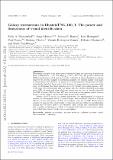Notice
This is not the latest version of this item. The latest version can be found at:https://dspace.mit.edu/handle/1721.1/132562.2
Galaxy interactions in IllustrisTNG-100, I: The power and limitations of visual identification
| dc.contributor.author | Blumenthal, Kelly A | |
| dc.contributor.author | Moreno, Jorge | |
| dc.contributor.author | Barnes, Joshua E | |
| dc.contributor.author | Hernquist, Lars | |
| dc.contributor.author | Torrey, Paul | |
| dc.contributor.author | Claytor, Zachary | |
| dc.contributor.author | Rodriguez-Gomez, Vicente | |
| dc.contributor.author | Marinacci, Federico | |
| dc.contributor.author | Vogelsberger, Mark | |
| dc.date.accessioned | 2021-09-20T18:23:03Z | |
| dc.date.available | 2021-09-20T18:23:03Z | |
| dc.identifier.uri | https://hdl.handle.net/1721.1/132562 | |
| dc.description.abstract | © 2019 The Author(s) We present a sample of 446 galaxy pairs constructed using the cosmological simulation IllustrisTNG-100 at z = 0, with MFoF,dm = 1011-1013.5 M☉. We produce ideal mock SDSS g-band images of all pairs to test the reliability of visual classification schema employed to produce samples of interacting galaxies. We visually classify each image as interacting or not based on the presence of a close neighbour, the presence of stellar debris fields, disturbed discs, and/or tidal features. By inspecting the trajectories of the pairs, we determine that these indicators correctly identify interacting galaxies ∼45 per cent of the time. We subsequently split the sample into the visually identified interacting pairs (VIP; 38 pairs) and those which are interacting but are not visually identified (nonVIP; 47 pairs). We find that VIP have undergone a close passage nearly twice as recently as the non-VIP, and typically have higher stellar masses. Further, the VIP sit in dark matter haloes that are approximately 2.5 times as massive, in environments nearly 2 times as dense, and are almost a factor of 10 more affected by the tidal forces of their surroundings than the nonVIP. These factors conspire to increase the observability of tidal features and disturbed morphologies, making the VIP more likely to be identified. Thus, merger rate calculations which rely on stellar morphologies are likely to be significantly biased toward massive galaxy pairs which have recently undergone a close passage. | en_US |
| dc.language.iso | en | |
| dc.publisher | Oxford University Press (OUP) | en_US |
| dc.relation.isversionof | 10.1093/MNRAS/STZ3472 | en_US |
| dc.rights | Creative Commons Attribution-Noncommercial-Share Alike | en_US |
| dc.rights.uri | http://creativecommons.org/licenses/by-nc-sa/4.0/ | en_US |
| dc.source | arXiv | en_US |
| dc.title | Galaxy interactions in IllustrisTNG-100, I: The power and limitations of visual identification | en_US |
| dc.type | Article | en_US |
| dc.relation.journal | Monthly Notices of the Royal Astronomical Society | en_US |
| dc.eprint.version | Author's final manuscript | en_US |
| dc.type.uri | http://purl.org/eprint/type/JournalArticle | en_US |
| eprint.status | http://purl.org/eprint/status/PeerReviewed | en_US |
| dc.date.updated | 2020-11-17T15:03:51Z | |
| dspace.orderedauthors | Blumenthal, KA; Moreno, J; Barnes, JE; Hernquist, L; Torrey, P; Claytor, Z; Rodriguez-Gomez, V; Marinacci, F; Vogelsberger, M | en_US |
| dspace.date.submission | 2020-11-17T15:03:57Z | |
| mit.journal.volume | 492 | en_US |
| mit.journal.issue | 2 | en_US |
| mit.license | OPEN_ACCESS_POLICY | |
| mit.metadata.status | Authority Work and Publication Information Needed |
